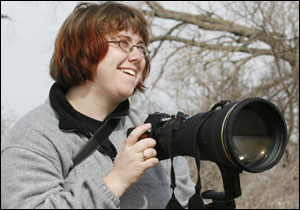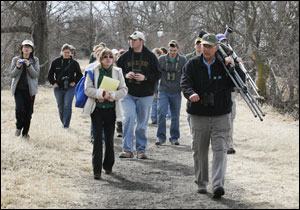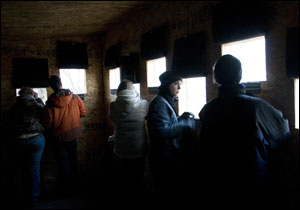Journalism Students Practice Reporting from Field During Spectacular Crane Migration
Columbia, Mo. (May 1, 2007) — Covering city hall, reporting on trials and profiling election candidates are beats many journalism students learn to cover. Documenting an extraordinary natural phenomenon, however, is a less typical assignment.

But for a group of students from the Missouri School of Journalism and the MU Agricultural Journalism Program in the College of Agriculture, Food and Natural Resources (CAFNR), a recent field trip and course provided the opportunity to witness first hand one of the Earth’s greatest wildlife spectacles: the spring migration of hundreds of thousands of Sandhill cranes through a small region of the Platte River Valley.
One morning in March, in the pre-dawn glow of central Nebraska, students from the School of Journalism and the Agricultural Journalism Program pointed microphones and jotted into notebooks as the large, gangly Sandhill cranes rose together off the shallow water of the Platte River, where they had spent the night. Their high-pitched, bleating calls exploded into a whirlwind of raucous sound. The students observed this natural wonder from a distance of only a few yards, hidden from the birds by a wooden blind on the edge of the river.

“It was one of the moments in my life that I know I will tell my children about,” said Katie Barnes, a master’s student in the School of Journalism. “The entire experience, from walking silently in the dark to the blind, to staring into the crane-chattering blackness on the river, to watching thousands of birds take flight against the backdrop of a sunrise — it was breathtaking.”
Barnes was one of 10 students from the School of Journalism and CAFNR who participated in the special field trip and course on covering the Sandhill crane migration and related environmental and agricultural issues. The course, offered for the second year, was led by Bill Allen, coordinator of the MU Agricultural Journalism Program and adjunct faculty member in the School of Journalism.

The Agricultural Journalism Program is a partnership between the School of Journalism and CAFNR. Agricultural Journalism students acquire journalism skills by working for the School of Journalism’s various media while also developing an extensive background in agricultural science or business through their CAFNR coursework.
This year, the students from the School of Journalism and CAFNR joined 20 MU ornithology students from March 9-11 for an eight-hour trip to the crane stopover region around Kearney, Neb. Biology graduate students Jennifer Hamel and Robin Hirsch-Jacobson led the birding students. The School of Natural Resources, housed within CAFNR, provided vans for the expedition.
Every year, about 600,000 Sandhill cranes from as far south as Cuba stop for a month along the Platte on their way to final destinations in Canada or Siberia. The cranes sleep while standing in the river at night to avoid predators and forage in fields and wetlands surrounding the river during the day. This respite allows them to put on extra weight and build energy reserves for the rest of their journey.

In class meetings before the trip, Allen encouraged each of his students to produce a piece of journalism about the trip, whether they were taking the one-hour course for credit or just coming along for the experience. Students’ work included a photo essay, a feature story in the Maneater, the University’s student-produced campus newspaper, and a convergence feature for the Columbia Missourian, the city’s morning newspaper, which also functions as a working laboratory for students in the School of Journalism.
“This journey gave journalism students interested in science, environment, conservation and natural resources an opportunity to witness a dramatic event that connects issues of people, politics, economics and nature,” Allen said. “It also gave them experience in reporting from the field.”
Julia Shuck, a freshman agricultural journalism major, said she was awe-struck by the cranes and enjoyed rubbing elbows with a number of international students who participated in the field trip. But among her most valuable learning experiences was watching fellow students work for the “perfect” photo or ask probing questions to their guides and conservation officials.
“This was something I was able to witness firsthand, not in the classroom and not from job shadowing someone,” Shuck said. “Being a part of a group like this, I was able to see journalism at work and in more than just one way.”

Making the trip to Nebraska also gave international students an opportunity to expand the scope of their journalism experiences while studying at Missouri. Hsin-Yin Lee, a master’s student in the School of Journalism from Taiwan, said she was fascinated by everything about the trip, from riding in the vans, to staying in the hotel, to watching the cranes fly over the Platte River.
The students participated in three major events over the weekend: observing the cranes coming back to the river to sleep at night on Saturday evening; watching the cranes from a blind on Sunday morning as they left the river to forage; and visiting the Squaw Creek National Wildlife Refuge in northwest Missouri to view another bird species, the snow goose, on its migratory route north.
Of all three events, the experience in the blind on the morning of March 11 was the most memorable for the majority of students, who held their breath as the sun rose and the valley filled with the sounds of chattering cranes and beating wings.
One of the students in the blind was Yuliya Medvedeva, a master’s student in the School of Journalism from Russia.
“I cannot describe what I saw when they started taking off after the day broke,” Medvedeva said. “I don’t quite remember how it happened, but I remember that it felt like a miracle.”
Updated: April 17, 2020